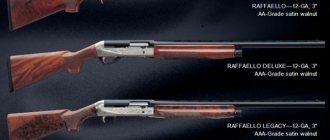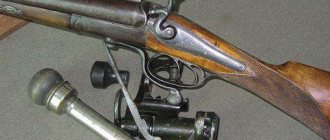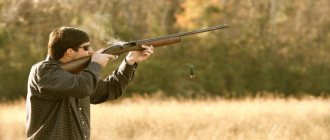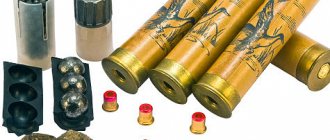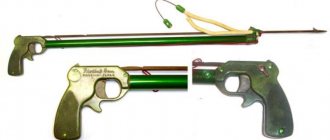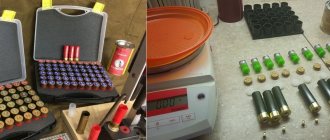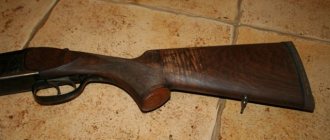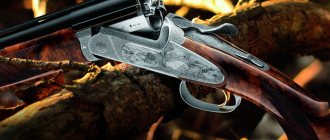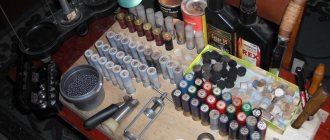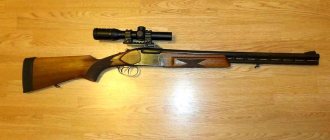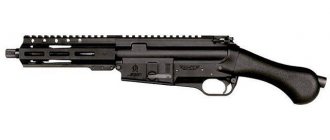Before you go hunting, you need to check the action of the gun and shoot it. Otherwise, you may encounter many surprises and come to the false conclusion that the gun is no good.
The fact is that the gun, despite the simplicity of its design, the machine, so to speak, is quite capricious. Hot days arrived and the gun with normal loads began to give heavy recoil; the temperature dropped to minus 35° - and the game suddenly began to escape unharmed when fired with the same cartridges.
They changed the cartridges or wads, put in a little more (less) gunpowder or shot, and the battle was no longer the same, or even completely “disappeared,” as the hunters put it. Therefore, having bought a gun, you first need to check it, and then shoot it with shot, buckshot and bullets.
Checking the fire of a gun is, first of all, checking the accuracy of its fire, determining the penetrating ability of pellets or their speed at the target (“sharpness of the fight,” as hunters usually say). Shooting is carried out at a distance of 35 m at a sixteen-lobe target.
Checking the firing of a gun
The shotgun fire test must be carried out using cartridges with shot No. 7 or 6 at a temperature of plus 15-20°C. The firing of a gun is checked if it is necessary to compare its passport data with the firing of cartridges from a factory shell or your own equipment, as well as when determining the parameters of a shotgun shot if the gun does not have a passport.
Zeroing a gun is shooting from a gun with the cartridges that will be used for hunting, at the air temperature expected in the hunting area, and at the distances at which it is intended to shoot game; zeroing a gun is necessary to determine the capabilities of a gun and cartridges for a specific hunt for a specific game.
When checking the accuracy of a gun, you should remember that it depends not only on the size of the muzzle constriction, but also on the shape of the choke, as well as on the method of loading the cartridges. But if we take into account only the magnitude of the muzzle constriction, then we can draw (to guide a young hunter) the following very arbitrary figures: in a 12-gauge gun, the cylinder gives an accuracy of 30-35%, an improved cylinder - 35-45%, pay - 50- 55%, medium choke - 55-60%, full choke -60-65%, strong choke - 70% more.
When shooting a gun, you should achieve such accuracy of fire that three to five pellets of the corresponding number hit the target - the game carcass (see the next section for the use of different shot numbers on different hunts).
If maximum accuracy is not always required, then sharpness, on the contrary, is always desirable. Unfortunately, the hunter himself is not able to determine the speed of flight of pellets at the muzzle or 35 m from it, so he must rely on published shooting data, having a fairly clear idea at what ratio of the masses of gunpowder and shot the projectile of the latter will receive the energy necessary to kill game (for a table of powder and shot weights for guns of all calibers, see the section on loading cartridges).
— Checking using shadow triangles.
If the gun passed the first test successfully, we perform a shadow triangle analysis. It gives more accurate information about drilling and bending of trunks. We place the light (artificial is more convenient here) at an angle of 90 degrees from above or below. We take the gun in our hands and hold it at a distance of 7-8 cm from our eyes. At the border of light and shadow from the side of the muzzle we find a shadow located on the lower surface of the channel. When positioned correctly, it will have the shape of a triangle with equal sides.
If the drilling and soldering of the barrels is done professionally, all sides of the triangle will be straight, without breaks or streaks in straight lines. We turn the barrel first in one direction and then in the other direction by 90, 180 and 360 degrees. The shape of the triangle should remain the same. If the soldering is done well, when the barrel is rotated 360 degrees, the shadow will be determined by an isosceles triangle, the base of which faces the eyes.
Below are examples of shadow triangle checks for uneven or incorrectly soldered tables. If shadow distortion is observed, the gun is rejected. This indicates the presence of a bend in the trunk.
Homemade ways to check the sharpness of a gun
There are several homemade ways to test the sharpness of a gun, the most common of which is shooting at dry (only dry) pine or poplar boards. If, when shooting at such boards at a temperature of plus 15 to plus 20 ° C, the pellets enter the tree four of their diameters, then the sharpness of the battle is excellent, if three is good, if two is satisfactory; if the pellets barely cut into the board, the sharpness is poor. This means that it is necessary to increase the flight speed of the shot, which is achieved either by increasing the charge of gunpowder, or by reducing the shot shell, or even by replacing wads with gunpowder, for example, felt wads with polyethylene ones; in this case, however, it is necessary to reduce the powder charge. Then the deviation of the average point of impact from the aiming point (from three to five shots) to the intended firing distance is determined.
Having determined the deviation (it should not exceed 10 cm), measure the correction and determine the amount of displacement of the aiming point from the point of impact to make corrections when aiming while hunting.
If it is possible, by changing the size of the sighting devices, to combine the aiming point and the point of impact (of course, if they are not aligned), then this must be done.
Rice. 1. Sixteen-section sighting target.
— Check using a cartridge case without a primer.
This method of checking ring concentricity is similar to the first, but gives a more accurate result. We insert the cartridge case without a primer (remember that the caliber must be suitable for the selected gun) into the chamber. We point the barrel with the breech towards the light source. From the muzzle side we see clear contrasting rings along the entire length of the barrel. They must be in perfect shape. Any deviation from the shape of the circle - curvature, displacement, ovality - indicates incorrect drilling of the barrel. You can't choose a gun like that.
Aiming points and impact points
After determining and combining the aiming point and the impact point (which is especially important when shooting with a bullet or buckshot), the accuracy of the battle is determined. This is done as follows. Draw on any transparent material (tracing paper, plastic film, plexiglass, etc.) a 16-part target, which consists of an inner circle with a diameter of 37.5 cm and an outer circle with a diameter of 75 cm.
Then both circles are divided into four equal parts, and each D. part of the outer ring is divided into three more parts, resulting in 16 equal parts. The area of the target is 4417.86 cm², the inner circle is 1104, the ring is 3313, one lobe is 276 cm². For example, let’s look at a shot from a 12-gauge shotgun with a cartridge loaded with shot No. 7; in the shell - 380 pellets.
Shooting is carried out on white sheets of paper measuring 1X1 m. When a 16-part transparent target was placed on this sheet and the center of the shot scree was aligned with the center of the target, 287 holes were obtained, limited by the outer circle of the target.
Divide 287 by 380, multiply by 100% and get 75%. This is an indicator of the accuracy of the gun’s combat. The higher this indicator, the longer-range the gun, but the more difficult it is to hit at short distances (15-20 m); when hit, the game is broken and unfit for consumption. The possibility of hitting game anywhere on the target in our example is assessed as follows.
— Measurement of wall thickness.
This is the final analysis that needs to be done when choosing a gun barrel. We use a caliper or micrometer.
It is necessary to measure the thickness of the walls of the muzzle and breech, and then compare them with the figures indicated in the documentation. The average figures are 2 mm for choke and 1.5 mm for pay. The thickness of the walls of the breech is 4.1-4.5 mm, at the end of the chamber - 3.4-3.8 mm. These are accepted standards. The thickness of the walls determines how much charge the weapon can withstand. If the numbers obtained during the test do not fall within the specified intervals, it is better not to purchase such a gun for hunting.
When purchasing an old, heavily used gun, pay attention to both its external condition and the internal bores. If the outside of the gun is shabby, very worn, and the internal channels are in perfect condition (shine like a mirror), most likely the barrels have been shunted. Some of the metal was removed from them to remove the shells. Such weapons cannot be used.
I hope that this article was useful to you; I will talk about other criteria for choosing a gun in the next article.
How useful is the publication?
Click on a star to rate!
Average rating 0 / 5. Number of ratings: 0
No ratings yet. Be the first to rate.
Fraction number 7
Shot No. 7 is used to shoot fairly small game. Let's take game with a slaughter zone area of 55 cm², for example teal cod. This area corresponds to the area of one lobe (276:55=5). Three pellets are enough to reliably kill a game of this size. This means that in order to hit a game, you must have at least three holes anywhere on the target, in other words, at least 15 pellets must hit each lobe (3X5 = 15).
To reliably hit game, due to the unevenness of the shot scree in each lobe, it is necessary to have a slightly higher density of holes in the target. If we evaluate the entire area of the target, then it is necessary that it be hit by 240 pellets (15 is the required number of pellets in a lobe, 16 is the number of lobes in the target, hence 15X16 = 240).
The possibility of hitting a target should be determined by shooting not only at a distance of 35m, but also at the distances at which you will have to hunt. If shooting will be carried out at a distance of 45 m at a certain game, then it is necessary to check the firing of the gun in combination with cartridges equipped with the corresponding shot numbers at exactly this distance.
— Checking the soldering of barrels.
When choosing a gun barrel, you need to pay attention to the sighting bar.
During the manufacturing process of a weapon for hunting, it is soldered to the barrel blank. To check the soldering conditions and the quality of its execution, you will need 2 pencils. We attach the barrel itself to one of them (you can use an under-barrel hook or swivel for this), and with the second we carefully but forcefully hit the barrel. A ringing and clear sound indicates high-quality soldering. The choice of weapon in this case is justified. If the sound is dull or rattling is heard, do not use this weapon.
If results are unsatisfactory
If the results are unsatisfactory, you need to change the method of loading cartridges, and if this does not help, then reduce the firing distance. How to select charges for zeroing? If the 12-gauge gun is light (weight 2.9-3.0 kg), then zeroing can be carried out as follows: take paper or plastic cartridges (certainly new), “Zhevelo” capsules, standard felt and cardboard wads, “Falcon” gunpowder , shot No. 7 and load several series of cartridges (how to load them, see the corresponding section).
You can start with the following weights: “Falcon” -2.2g, shot - 32g. If the accuracy turns out to be insufficient, you should equip a new series of cartridges with the same mass of gunpowder, but increase the mass of shot to 33 or, if necessary, to 34 g. But it also happens that the recoil from a light gun will be unbearable. Then, when loading the third series of cartridges, you need to reduce the weight of gunpowder - take only 2.1g of “Falcon” and 32g of shot, etc. Shooting should be carried out until you achieve the required accuracy of the battle.
With more powerful 12-gauge shotguns weighing 3.2-3.5 kg, you can start zeroing with 2.2 g of “Falcon” and 33 g of shot, bringing, if necessary, the shot shell to 36 g, and the powder weight to 2, 3g. Guns of other calibers are also sighted; weights of gunpowder and shot for them are indicated in the section on ammunition.
When shooting a gun with buckshot, you need to achieve the following results: at a distance of 35 m, at least 75% of the number of buckshot in the projectile should hit a circle with a diameter of 75 cm. This means that from a projectile with 12 buckshots, at least 9 buckshots must hit the target, from a projectile with 16 buckshots, at least 12, etc.
— Checking the muzzle.
The next important check concerns the muzzle. It is he who is responsible for how correctly the projectile leaves the gun. If you are dealing with a used gun, this analysis will show how much wear the gun has and what condition it is in.
If there is a chamfer on the cut, it indicates that the weapon has been in use for a long time. The rounded inner edge indicates a large shot. The ideal muzzle of a smooth-bore weapon has a regular rounded shape. External and internal edges must be clearly defined.
The simplest and most well-known way to check the muzzle when choosing a weapon is to press it with a soft palm pad in the thumb area. The fingerprint on the hand will already allow us to draw conclusions.
Zeroing a gun with a bullet
The gun must be shot with special care. Shooting a bullet is a responsible matter: after all, you have to shoot at animals such as elk, wild boar, and sometimes a bear. Of course, the higher the initial speed of the bullet, the greater the energy of destruction, the cleaner the game. But as the weight of gunpowder increases, accuracy quickly begins to drop, since with very strong charges the vibrations of the barrels sharply increase. In addition, already in the barrel the soft lead bullet is greatly deformed, which further reduces the accuracy of the fire and thereby the accuracy of shooting.
Modern bullets such as Brenneke, Vyatka, Sputnik, Mayer and others, when hitting the slaughter area, give a reliable kill. Therefore, in 12-gauge guns, these bullets (with their mass of 32-35 g) must be shot with charges of Sokol gunpowder of 2.3-2.5 g, depending on the air temperature, weight and condition of the gun. Attempts to equip cartridges with large amounts of gunpowder (2.7-2.8 g of Sokol) usually lead to an increase in the spread of bullets and therefore sharply reduce the possibility of an accurate hit at the slaughter site. It is necessary to zero the gun with bullets not at 35, but at 50m, since it is often at such distances that you have to shoot at an elk or wild boar.
You should not shoot bullets from a smooth-bore weapon further than 50m, since at long distances the energy of the bullets drops sharply, and their spread increases so much that aimed shooting becomes impossible. If at 50m the bullets fall in a circle with a diameter of 10cm, the fight is excellent, in a circle with a diameter of 15cm - good, 20cm - satisfactory.
But at the same time, you need to check the firing of the gun at 15-20m: short shots happen, and the hunter must know how the bullets from his gun fall at such a distance. When zeroing a gun, you must fire at least three (preferably five) shots from each barrel with cartridges of the same series.
♦ When inspecting the assembled gun, the following is checked:
Are there any rust, dirt, as well as dents, scratches and nicks on the external metal parts, which can cause disruption of the normal operation of the mechanisms, changes in the combat and damage to the shooter’s hands;
Are there any cracks, chips, bruises, or damage to the cosmetic coating on the wooden parts?
♦ When inspecting a gun in disassembled form, each individual part and each mechanism is examined in detail, it is checked to see if there is any rust, dirt, clogging, cracks, crushed metal, and whether the mechanism is functioning properly.
♦ Inspection of trunks.
Barrels have two types of defects: manufacturing defects and defects that arise during operation.
Manufacturing defects include: poor-quality filing of barrels (hairiness), poor-quality drilling of barrels, curvature of paired barrels due to improper soldering of the sighting bar.
Defects that occur during the operation of weapons include erosion and corrosion of barrels, dents and swelling of barrels, and even ruptures of barrels.
The trunks must have a flat and smooth surface, without potholes, scratches or swelling. The blued or galvanized finish must be free of abrasions, discoloration and scratches.
It is convenient to check the outer surface of the trunk by the light glare from the light falling on the trunks. This highlight should go with a constant narrowing from one end to the other without a break.
The shadow determines whether the trunk has a hairiness or not.
Rice. Pea-shaped swellings on the underside of the left barrel of the IZH-54 gun
If the filing of the trunk was done without grabs, then the shadow will be straight, otherwise the edge of the shadow will be zigzag. This defect of the gun is considered very serious, since after filing the barrels may become different in thickness.
Rice. Inflating a shotgun barrel without tearing the metal
The quality of the barrel drilling can be checked in two ways.
In the first case, it is necessary to insert a sleeve with a hole for the Zhevelo capsule into the chamber and point the breech of the barrel at the window and look from the muzzle into the barrel. Concentric shadow rings will be visible in the trunk.
If the barrel is straight, then all the rings will be located correctly - one inside the other. If the rings seem to be shifted, then there will be a deflection in this place.
Rice. Detection of defects on the outer surface of the barrel by a light flare: a - a well-processed serviceable barrel (the edges of the flare have a strictly straight line without kinks or curvature); b - a barrel with poor external mechanical processing (has a wavy surface, the highlight sometimes expands and then narrows); c — a bent trunk (the highlight bends and expands at the bend of the trunk); d - barrel with an annular bulge in the muzzle before the muzzle constriction (the flare forms a sharp widening of the edges before the bulge, and then sharply narrows at the bulge itself)
Rice. Detection of drilling defects by concentric shadow rings: a - barrel without defects; b - the trunk is bent to the right; c - the trunk is bent to the left
Rice. View of a shadow triangle in the presence of a metal snatch or swelling (left) and a dent (right) in the barrel bore
In the second case, the barrel is directed to the edges of the window frame in an inclined axis position. A dark shadow triangle will be clearly visible in the bore.
With perfect drilling, this triangle should be regular and isosceles. In a cylindrical drill barrel, its top reaches the muzzle edge, and with a choke drill, it ends at the beginning of the muzzle constriction. At the same time, from the side of the muzzle of the barrel, a second small shadow triangle formed by the muzzle constriction is visible. The vertices of these triangles, if you lift the trunks, are connected.
When the barrel rotates around its axis, the outlines of the sides of the triangles do not change.
If there are snags or narrowings in the trunk, then the outlines of the triangles will have an irregular shape. This defect is very significant and irreparable. You won't be able to get a proper fight from such a gun.
Curvature of barrels due to soldering of the sighting bar is observed even in very good brands of shotguns. This defect can occur anywhere, but most often it occurs in the thinnest area.
If you look at such a trunk in the light, then some of the rings will be shifted in the direction where the trunk is curved: on the concave side, some of the rings are very close together, and on the opposite side they are spread apart.
Curvatures can be of two types: narrowing trunks and spreading trunks. Such guns will have a shift in the center of the shot towards the curvature.
The curvature of the trunks due to their soldering together cannot be repaired.
The swelling of the barrels occurs mainly before the muzzle constriction in the thinnest place of the barrel (500–520 mm from the breech) or at the end of the chamber, at the point of the projectile entry.
The shape of the swelling of the trunks can either be in the form of a small protruding ring, or a slight elevation - a pea, or in the form of a large swelling - a nodule, which is almost always accompanied by a metal crack.
Swelling of the barrel before the choke and even separation of the muzzle of the barrel occurs from the entry of a foreign body into the barrel and from shooting from smooth choke-drilled barrels with round bullets whose diameter is larger than the diameter of the barrel muzzle opening, as well as Brenneke and Jacan bullets, the body of which is wider without leading ribs muzzle hole.
Next, you need to hang the barrels by the front under-barrel hook and look at the soldering of the straps: for guns with horizontal barrels - top (sighting) and bottom, for guns with vertical barrels - side and sighting.
The soldering of the sighting and side rails must be of high quality, the seam must be of the same thickness along the entire length, the holes between the rails and the barrels at the muzzle must be closed with solder.
Tilting to the side or turning the aiming bar in a helical manner is not allowed, as this will negatively affect the shooting result.
Minor deformations that occur when soldering the straps in the first (from the chamber side) third of the barrel have virtually no effect on shooting results, which cannot be said about the same deformations in the immediate vicinity of the muzzle.
There should be no gray coating in the soldering areas.
Poor soldering is detected by tapping the strips with a stick and making a dull rattling sound.
Factory soldering, especially on the side and bottom rails, is damaged either due to barrel vibration when fired or due to alkaline oxidation.
It is checked whether the front sight is positioned correctly and whether it is shifted to the right or left.
If the difference in the thickness of the walls of the barrels at the muzzle is visible to the naked eye, it is difficult to count on an even fall of shot when fired, and the distance between the average points of impact (MIP) may be excessive.
Remember that barrels do not last forever: they burn out and when using conventional primers and non-rusting capsules, non-chrome and chrome-plated barrels, made of ordinary, alloy and stainless steel, wear out.
In the bores of guns manufactured before 1963, which were not chrome-plated, when held up to the light, you can find:
Rust, which appears as dark spots. Rust that is not noticeable to the eye can be detected by wiping the bore with a clean rag, which in this case will leave brown spots on it;
Rash - primary damage to the barrel bore by rust;
When examined, the rash is observed in the form of dots or small specks located along the entire bore;
Rust marks are dark, shallow stains remaining after rust has been removed;
Sinks are significant depressions in the metal. In the chrome-plated bore
The following disadvantages may be observed:
The mesh swing is in the form of intersecting thin lines, usually from the breech. Subsequently, when shooting, cracks form in the areas of the reticle and chromium begins to crumble in the form of individual points, then the crumbling increases and turns into chips of chrome. If cleaning is not thorough enough, rust may appear in the areas where the chrome is chipped;
Sinks are a significant depression in the metal, formed as a result of a large number of shots fired from the bore (bore heat) or as a result of prolonged exposure to rust in places where the chrome has chipped. A barrel in which chips of chrome or shell have formed must be cleaned especially carefully after shooting. Both chrome-plated and non-chrome-plated barrels are susceptible to lead plating. Under a layer of lead, the trunk quickly rusts and shells appear in it.
Smoothbore shotguns have shallow shells and dark spots of rust that do not impair the action and do not pose a danger to the shotgun. True, such a trunk becomes dirty and leaded faster, and therefore requires more care. In heavily neglected trunks, the shells can be deeper than 0.1 mm, which is dangerous during shooting. As V. Pankratov recalls: “... rust in the barrel does not affect the combat of a shotgun.
I saw guns from the Belgian company “Defourny”, owned by Zhukov, one of the first honored masters of clay pigeon shooting. Although the barrels had shells from the chamber to the ejection, the guns had excellent action.”
♦ Check to see if the barrels are loose.
To check whether the barrels are loose in the block, it is necessary to remove the grease from the contacting surfaces of the barrels and the block. Then you need to remove the forend, with the locking mechanism open, place the pad of one of your fingers at the junction of the breech end of the barrels with the block guard and swing the gun in the transverse direction. The slightest sway of the trunks is immediately felt by the fingertips.
To check the longitudinal motion of the barrels, close the locking mechanism and also swing the gun in the longitudinal direction without the fore-end.
For guns, if the barrels fit well to the receiver block, the under-barrel hooks on both side surfaces should have traces of friction against the walls of the grooves of the block, and the more worn the surface is, the better the under-barrel hooks fit, the more durable the good connection of the barrels with the block will be.
After the inspection of the barrels is completed, you can move on to the next parts of the mechanism.
♦ The holes for the strikers in the shutter mirror are checked.
They may not be perfectly round, but their size should be commensurate with the diameter of the striker with a small gap.
The strikers must have a regular rounded shape in the form of a paraboloid and protrude by 1.7-1.8 mm.
♦ The forend fastening is checked.
The attached forend must be firmly secured with a clasp.
♦ The force of the triggers is checked.
The normal trigger force for hunting should be 1.8 kg for the right or lower and 2 kg for the left or upper trunks.
The force is checked by a spring steelyard. A strong thread is put on the escapement, and a measurement is taken at the other end through a loop thrown over the hook of the spring steelyard. When checking the rear descent, you need to pull the steelyard a little to the right and up.
♦ The operation of the fuse is checked.
It must be clearly fixed in both positions and reliably protect against an accidental shot.
♦ The work of the cockers is checked.
The cockers must begin to move at the same time as the barrels begin to move when opening the gun. Otherwise, the gun will be difficult to open, since the extended firing pins do not allow the gun to open and may even be bent. A sign that the cockers need to be adjusted are scratches on the primer and the bottom of the case.
♦ The trigger system is checked.
The release of the triggers must work, i.e. the trigger, after hitting the firing pin (or primer), moves back for some
angle back so that the firing pin can, under the action of its own spring, also move back behind the box mirror.
When cocking the hammers, there should be clear clicks, and the firing pins should have sufficient impact force on the primer, which is checked by the height of the jump of the metal sleeve placed above the firing pin when the hammer is released. This height must be at least 50cm.
♦ The operation of the locking mechanism is checked.
The locking mechanism should work without jamming or clanging, easily and softly. When closing the gun, the upper lever should fall into place on its own (only in a new gun is it possible to lightly press the key manually with a little effort).
♦ The condition of the box (block) is checked.
The check is carried out with special care, since the safety of the shooter depends on its condition.
♦ The operation of the extractor (motor) and ejector (automatic ejector) is checked.
Testing is carried out using training cartridges or metal cartridges without primers.
♦ The condition of the wooden parts is checked.
Wooden parts must not have cracks, dents, or chips, must fit well with metal parts, and not protrude more than 0.5 mm above their surface.
The gun barrel must be straight along its entire length. This is determined by the end of the rings. If a dry barrel is pointed at the border between the dark and light backgrounds of the window, then a number of shadowy concentric rings will be visible in the channel - reflections of the muzzle. These rings must be correct, located strictly concentrically, that is, one inside the other. Uniform convergence of the rings on one side and divergence on the opposite side indicate a curvature of the trunk. Where they diverge, the trunk is curved, and where they come together, it is concave. It must be remembered that an obliquely cut barrel has elliptical shadow rings even in an immaculate barrel. Sometimes the barrels of hunting weapons are pulled or bent due to strong heat during factory soldering. The straightness of the barrel channels should be checked both from the breech and from the muzzle. If the trunk is bent in the middle or the last third of its length, then it is difficult to achieve the correct fall from it. You can purchase such a gun after checking its firing or verifying this with your passport.
It is better to check the straightness of the barrel channels in another, more accurate way. The barrels should be removed from the stock and their channels should be wiped dry. Then, standing at a distance of 3m from the window, point the barrels with the muzzle at the middle of the top glass of the window frame. The breech of the trunks should be at a distance of 6-8cm from the eyes.
The bore of a hunting rifle will be illuminated inside evenly, without any shadows. Then you should slowly lift the muzzle of the barrel upward (until the extended axis of the barrel meets the frame wood). A sharp shadow figure should appear on the bottom side of the channel - a reflection of the top edge of the window. With a straight bore, this shadow will have the outline of an isosceles triangle with the base at the breech end and straight sides. When drilling a barrel cylindrically, the apex of the triangle will be located at the muzzle, and in barrels with chokes - at the transition to the muzzle narrowing, then a second triangle will be visible, its apex in contact with the first.
If there is even the slightest curvature in the trunks, then the isosceles sides of the triangle in this place will bend in the direction of the bend of the trunk. As the curvature of the trunk increases, the curvature of the sides of the shadow figure increases. When checking, each barrel is rotated 90 degrees, then 180, 270 and 360 degrees. If in this case the shadow triangles in all cases seem isosceles and the same, then the muzzle of the table of a hunting rifle is straight.
The correctness of the breech of the barrels is checked in the same way, only the barrels are directed towards the window with the breech and looked into them from the muzzle. If the shadow triangles turn out to be isosceles here too, then the trunk is correct. The brighter the daylight, the sharper the shadow triangle appears. Under artificial lighting, a sharp shadow cannot be obtained, so a special screen with frosted glass is required. An experienced hunter examines gun barrels for 2-3 minutes.
Checking the barrel of a hunting rifle is a mandatory procedure for every gun owner or potential buyer.
Its structure is designed in such a way that it can contain a lot of defects that arose already at the production stage or during use for hunting.
The most common problems with trunks, which absolutely any hunter can encounter, may be the presence of a rash in the bores, the appearance of shells, small swellings in certain places, or improper soldering and drilling of the trunks.
You need to check the barrels not only before purchasing a new or old gun, but also your own weapon, which you use annually for hunting.
This is due to the fact that during the hunting process there are various situations that create a danger of damage to the gun barrels.
For example, hunting in the summer or autumn season sometimes results in particles of grass getting into the trunks, which the hunter does not remove and shoots.
As a result, swellings are likely to appear in the bores of the barrels, which completely precludes further use of the gun.
In winter, in some cases, something similar happens, but instead of grass, there is snow in the trunks, which prevents the projectile from exiting during the shot and creates very high pressure.
This pressure sometimes literally bursts the barrel of a hunting rifle or causes swelling, so it is very important to ensure that there are no foreign objects in the barrels.
I think the reasons for the appearance of trunk defects in the form of swellings are clear, but here’s how to check for the presence or absence of incorrect soldering, drilling, or slight unevenness of the trunks.
For this procedure, you will need to take the barrels themselves and the cartridge case without a primer. The barrel bore should first be thoroughly wiped clean of grease. Next, we insert the cartridge case into the chamber and point the breech end towards the light, and look into the muzzle.
Thus, you will see the presence of shadow rings, which can have different shapes, but you need the rings to be absolutely identical and have a geometrically even circumference.
All rings must have a single center, since only in this case can we say that the gun barrels are in good condition.
If the shadow rings deviate in one direction or the other, this indicates the presence of defects in the barrels, so you can no longer buy or use this gun for hunting.
The presence of rust or rash in the barrels can be easily checked by simply looking at the light from a certain angle. A small rash practically does not interfere with the gun’s combat, but deep shells already preclude further use.
Some shotgun owners resort to burring the barrels to remove burrs and hide this problem.
This procedure involves removing a certain layer of metal in the barrel bore. As a rule, a layer is removed that corresponds to the depth of the shells.
After shuffling, the barrels become much thinner, which creates the danger of the barrels breaking in the future, so it is better not to buy guns with cranked barrels.
Checking the barrel, which is described in this article, will help you avoid mistakes when choosing a gun, so use the recommendations and shoot only from high-quality barrels.
Every hunter, when purchasing a gun, will definitely check it. This is necessary especially if you are purchasing a used weapon. However, even when buying a new one, you can’t do without checking. Proper and thorough inspection will help you choose a gun that will last for many years. But at the same time, after the purchase, you need to learn how to care for your purchase. How to check a gun before buying? How to make a choice and not make a mistake?
First of all, you need to pay attention to the appearance, although this is not the most important thing. However, at first glance you can understand whether it is made qualitatively or not. This aspect is especially important if the gun is not bought new in a store, but used. With the help of appearance, you can understand how the weapon was handled - carefully or carelessly. But this indicator does not always indicate the actual condition of the gun.
If you are satisfied with the external condition of the gun, then you need to move on to the internal contents. To do this, you first need to understand how guns are made, what components you should pay attention to first. First, you need to find out from the owner of the used weapon whether it has been subjected to rust. If yes, then it is better to refuse the purchase. Secondly, carefully inspect the table, magazine, receiver, trigger mechanism and all other parts that are made of metal; they may have corrosion or rust.
Choosing a gun in a store is much easier, and you can count on the help of a sales consultant. If you choose a used model, you also need to know how to determine the year of manufacture of the gun. It is also worth inspecting the barrel for wear and checking its serviceability. Sometimes traces of repairs may be visible; you need to check with the seller what the damage was and how it was repaired. The chamber must be in good condition, free of rust and dents. Don’t forget about the accuracy of the sight; if there are potholes on it, they will significantly interfere. And, of course, you need to evaluate what the gun looks like and how it was treated.
Another mandatory rule is to find out how the gun was cared for and what means were used for this. It is important that there are no traces of oils or solvents on all parts of the weapon. The lower part of the gun stock will best tell you about the shortcomings in caring for your gun. Before choosing a shotgun, you need to find out as much information as possible about the different models, their functionality and care rules. This will help with your pre-purchase inspection. In addition, you must definitely shoot from it several times and try to aim.
Selecting a weapon barrel and checking it completely.
In order for a hunting weapon to perform its functions correctly and safely for you, you need to be very careful in choosing it. The main criterion in this matter is the barrel of the weapon.
What do we need?
Here is a list of the necessary tools and devices that will be needed for a complete and high-quality inspection of the barrel:
— a flashlight (a small one will do);
- a sheet of A4 paper or a piece of pure white fabric;
- case without primer (check that it is your caliber):
— a cleaning rod with rubbing (also of the required caliber);
- micrometer or caliper.
Start of the test: visual analysis.
The outer part of the trunk.
We inspect the weapon very carefully, especially if we take a used one. The trunks should not have any scratches, much less dents. The entire length of the trunk should be even and smooth.
When choosing a gun that is not new, avoid models made of Damascus steel. This material will be indicated by the embossed words “twist”, “laminated” or “Damascus”, as well as spiral structures.
The gun must have a stamp that allows the use of smokeless powder (another name is nitro).
Inner part of the trunk.
The internal channels must be completely free of pitting, that is, pitting corrosion.
Let's proceed to the main check.
Using a device to measure the length of the barrel's charging chamber
Using the firing table from the section “Determination of the correction for the drop in the initial velocity of the projectile” (for a given artillery gun), determine the numbers (diameters) of the measuring ring and guide disk and select them using the Appendix Sets of measuring rings and guide disks in sets of PZK devices.
Place a tube on the main rod, screw the rammer rod all the way into the rod, put a guide disk of the required diameter on the tube and secure it with a nut, put a measuring ring of the required diameter on the end of the main rod and secure it with a nut.
Wipe off the grease on the measuring ring and guide disk with a rag, which will come into contact with the surfaces of the barrel during operation.
Place the gun barrel in a horizontal position, separate the bolt and wipe off grease from the chamber and the rifled part of the barrel bore at a length of 400-500 mm; It is not recommended to wipe the chamber and barrel without separating the bolt, since if the bolt is accidentally dropped from the ejector legs, the tool and even hands may become pinched.
Insert the assembled PZK device into the gun chamber with a measuring ring and advance it to approximately half the length of the chamber, turn the main rod with the numbers up.
Smoothly push the tube forward until the guide disk flange stops at the rear section of the barrel tube, so that the cutouts on the guide disk flange do not touch the ejector legs. Smoothly pressing the rammer handle, push the assembled PZK device into the barrel bore without shock until the measuring ring stops at the beginning of the barrel rifling.
Smoothly press the rammer handle with such force (about 20 kgf) that the front end of the cartridge case aligns with the mark on the rammer rod; in this case, due to the compression of the spring, the force of sending the measuring ring will be 20 kgf.
Using the scale on the main rod (extension) and the rear section of the tube, determine the length of the barrel's charging chamber in millimeters. Take measurements three times and take the arithmetic average as the length of the charging chamber.
Remove the PZK device by hitting the end of the rammer sleeve several times with a hammer (moving the hammer along the rod). After the measuring ring comes out of the rifling, remove the PZK device from the barrel, disassemble it, restore the damaged lubrication and put it in the case.
To determine the elongation of the barrel charging chamber, it is necessary to subtract the initial length of the charging chamber indicated in the gun registration form from the obtained (measured) length of the charging chamber. If the form does not indicate the initial length of the charging chamber of the new barrel, take the drawing value indicated in the shooting tables.
The magnitude of the drop in the initial velocity of the projectile is determined according to the instructions in the shooting tables.
General rules for handling and using calibers
To ensure the quality of weapons in use and stored in military units, it is necessary to check them in a timely manner.
One of the methods for checking the quality of weapons is periodic inspections with measurements using military calibers.
Newly arriving calibers to military units should be subject to control inspection and routine maintenance; calibers with expiring dates for the next verification, as well as those subject to long-term storage, should be verified at LIT.
Calibers must be in their standard cases (boxes, pencil cases) with weapons according to stowage diagrams (lists), in workshops - at work stations or in cabinets.
It is allowed to store only passports (forms) and individual spare parts for calibers in cases with calibers.
Manual mechanical sprockets, PZK devices and PKI devices should be carried and stored only in standard cases; At workplaces, these calibers may be kept assembled on wooden stands made like the stands of standard cases and preventing the deflection of these calibers.
To check weapons, it is allowed to use calibers of the 1st and 2nd categories that have a valid imprint of the verification mark, a certificate or certificate certifying the fact of their verification, and with no expired verification dates.
The calibers and the weapon being tested must have the same temperature, therefore, before checking, the calibers and weapons must remain together for at least 2 hours.
If calibers are moved from a cold room to a warm one, they must be placed away from the heating device, allowed to sweat along with their cases, and then wipe them dry with a rag and lubricate them with MZ grease.
Use gauges only for their intended purpose for checking the intended dimensions; they must be protected from impacts, falls, distortions during measurements, from contamination, mechanical damage, moisture and the influence of aggressive environments (substances).
Before checking, wipe the working surfaces of calibers and parts of the weapon being checked dry; check that * the parts of the weapon being checked are free of nicks, burrs, dents and other defects that distort the test results and (or) cause damage to the calibers.
If the pass-through calibers do not pass, the mating part of the weapon must be inspected; If defects are found on it that prevent measurement, eliminate them, and then carry out the necessary check.
When working with complex gauges (quadrant, mechanical hand sprocket, wear monitoring device, etc.), it is necessary to protect them from the ingress of water, aqueous solutions, solvents, abrasive materials, since in order to remove these contaminants from the caliber mechanisms they must be disassembled in a specialized workshop for repair of measuring instruments.
Check the force on the flywheels of the mechanisms either when moving away from a place, or during steady motion, as indicated in the operational documentation for the sample being tested; If in this documentation only the magnitude of the permissible force is given, assume that this is the magnitude of the force on the flywheel during steady motion.
When checking the force of release from a combat cocking, hook the hook of the device to the middle part of the trigger and direct the force parallel to the axis of the barrel bore; Apply force to the trigger levers perpendicular to the working platform (trigger) of the trigger lever or in the direction of the natural movement of the finger (hand).
At the end of each working day, wipe the used calibers with a rag soaked in gasoline, lubricate them with a thin layer of MZ grease and place them in cases.
Using a checker gauge to check the locking unit
To check (adjust) the locking unit with checker calibers, open (separate) the receiver cover, separate the return spring, lift up the receiver (receiver base), move the moving system back so that the bolt cup does not reach the reflector, insert a caliber into the bolt cup the checker, placing its edge under the ejector hook, smoothly move the moving system forward by hand and press the bolt frame with the force specified in the repair manual for the sample being tested. In this case, the pass-through gauge-block must be covered with a bolt, the non-pass-through gauge-block must not be covered with a bolt, and the fitting gauge-block, used only for fitting the parts of the locking unit, must also not be covered with a bolt.
After checking, smoothly move the moving system back without hitting the caliber block on the reflector and push the caliber block out of the bolt cup, keeping it from falling to the floor.
It is prohibited to:
- insert a caliber block into the chamber of the barrel and send the moving system forward under the action of the return spring;
-sharply send forward the moving system with a caliber-checker inserted into the bolt;
- with the block caliber inserted and the moving system sent forward, strike the moving system in order to obtain the blocking of the block caliber by the bolt.
Using a gauge to check the distance from the bottom of the bolt cup to the ejector hook
To check the distance from the bottom of the bolt cup to the ejector hook with the non-pass side of the caliber, the ejector must be pressed forward (in the direction of increasing the size being checked), and when checking the pass side of the caliber, the ejector must be recessed into the bolt (in the direction of decreasing the size being checked).
When checking, press the caliber against the bolt cup and rotate (push) it without applying force under the ejector hook; in this case, the pass side of the caliber must pass under the ejector hook, and the non-pass side of the caliber must not pass under the ejector hook.
